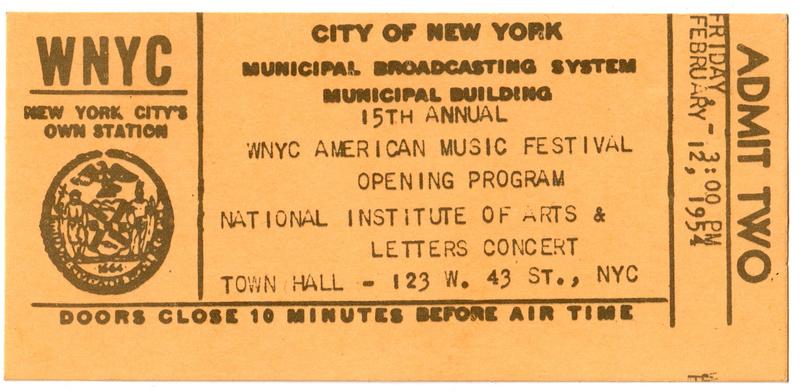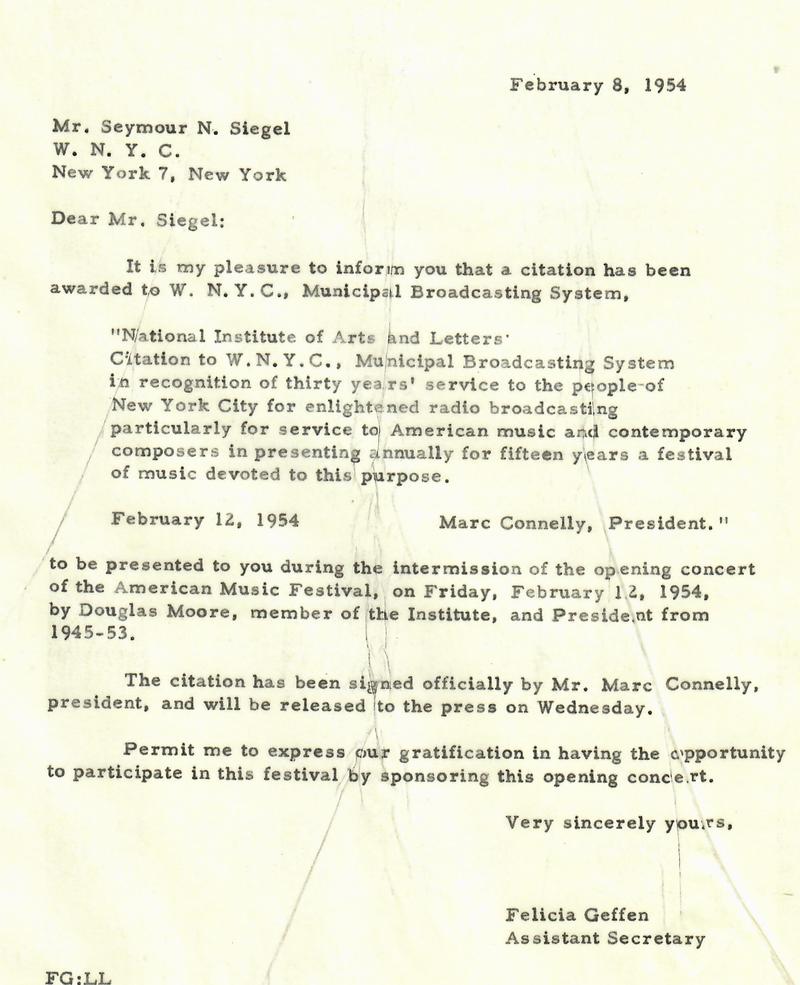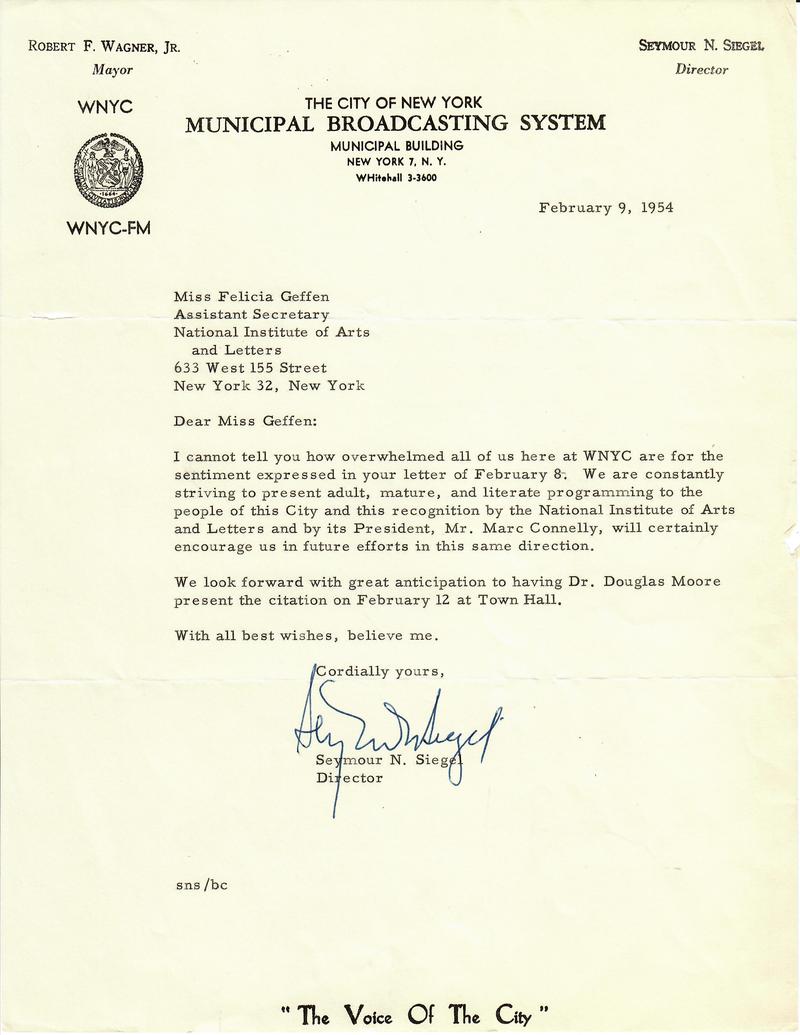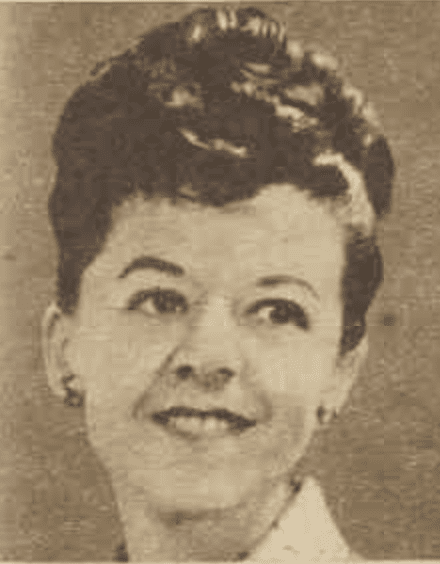 NYPR Archives & Preservation
NYPR Archives & Preservation
An Award for WNYC, a Concert, and the Raised Hackles of a Times Reviewer

On Feb 12, 1954 the National Institute of Arts and Letters, in cooperation with the National Orchestral Association, presented the opening concert of WNYC’s 15th annual American Music Festival. The concert took place at Town Hall and celebrated not only three American composers (including one controversial work), but WNYC’s three decades of “enlightened radio broadcasting.”
Only a few days before, WNYC had learned that the National Institute of Arts and Letters was to present a citation during the concert’s intermission. In addition to mentioning “thirty years of service to the people of New York City,” the citation specifically highlighted the station’s “service to American music and contemporary composers.” Naturally, the station was thrilled to received such an accolade from the prestigious organization. It was also the first time the institute had cited a media organization.
WNYC's Response:
In presenting the citation to WNYC during the concert, the composer Dr. Douglas Moore, a former president of the institute (1945-1953), spoke of the public's affection for the station and its listeners.
To be with the musical audience of WNYC is probably the most enviable position that a musician can have. I doubt if there is a more distinguished and more intelligent audience in the United States than the one which listens to the concerts which are broadcast by station WNYC.
The concert itself featured musical compositions of the institute's most recent (1953) awardees for composing: Roger Goeb, Peggy Glanville-Hicks, and Nikolai Lopatnikoff (event audio above). It began with the premiere of Goeb's Concerto for Violin and Orchestra, performed by the National Orchestral Association orchestra under the baton of Leon Barzin and with Morris Wilk as soloist; it was followed by Glanville-Hicks’ Letters from Morocco for tenor and orchestra, featuring William Hess. The program concluded with the New York premiere of Nikolai Lopatnikoff's Divertimento for Orchestra, Opus 34.
Peggy Glanville-Hicks’ Letters from Morocco generated by far the most controversy. The work is based on correspondence from her friend, expatriate composer, and writer Paul Bowles, who had settled in Tangier in 1947 --where he could write in peace, and among other things, indulge in hashish. Glanville-Hicks felt that her work would not make sense without the text of Bowles' letter-poems, so they were provided in the original 1954 event program.[1] Here is a letter excerpt/song number four:
I have found a new candy, - hashish almond bar.
I shall bring you some.
It's absolutely unbelievable in its effects, but you have to eat it carefully - like Alice nibbling the mushroom, otherwise --- the transportation is rather sudden, like gusts of golden wind along the vertebrae, and an upward sweep into the clouds.[2]
You can probably guess where this led. New York Times reviewer John Briggs, Jr., who called Bowles' prose "pretentious hokum" and suggested that composer Hicks had "wasted her considerable gifts for lyric invention and ingenious instrumentation," posed the following questions in his review:
Still, with the nation alarmed by the rising narcotics addiction, the question may be raised whether the Institute's name should be linked with a work that glorifies the sensations induced by narcotics. On this basis, would not hashish makers of North Africa be within their rights in labeling their product 'endorsed by the National Institute of Arts and Letters?'[3]
While WNYC came away unscathed, there's little doubt that the temper of the times- then a preoccupation with McCarthyism, juvenile delinquency, and drug abuse- had influenced the harsh critique.
In stark contrast, the work ruffled no feathers when it premiered a year earlier at the WNYC American Music Festival under the baton of Leopold Stokowski at the Museum of Modern Art. Written for a tenor and orchestra, the piece featured William Hess as the soloist at both performances. Letters from Morocco was scored with one flute, oboe, bassoon, trumpet, and harp instead of piano.
The February afternoon's third and final work was the New York premiere of Nikolai Lopatnikoff's Divertimento for Orchestra, Opus 34. In contrast to Letters from Morocco, music critic Briggs called it "a deft, competent, and pleasant work."[4]
_______________________________________
[1] Geffen, Felicia, letter with concert program to WNYC music director Herman Neuman, February 12, 1954.
[2] Ibid.
[3] Briggs, John, "WNYC Music Fete Offers 3 Works," The New York Times, February 13, 1954, pg. 11. Note: Deborah Hayes, writing on Peggy Glanville-Hicks in The Musical Woman: An International Perspective, Vol. III 1986-1990, describes benign, if not positive, reviews for 1953 primiere of Letters from Morocco coming from the ACA Bulletin, (American Composers Alliance), The New York World Telegram & Sun as well as Times' Olin Downes. See: Zaimont, Judith Lang, The Musical Woman, Greenwood Press, Westport, Ct., 1991, pg.383.
[4] Ibid.
Special thanks to the American Academy of Arts and Letters for digital document scans from their collections and to the New York City Municipal Archives for the WNYC concert audio.
Note: The National Institute of Arts and Letters merged with the American Academy of Arts in 1976 under the name American Academy and Institute of Arts and Letters. For the official history, please see: American Academy of Arts of Letters/History.


